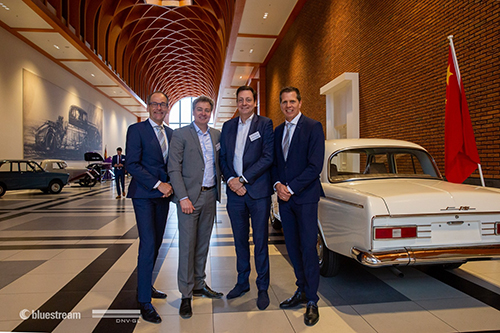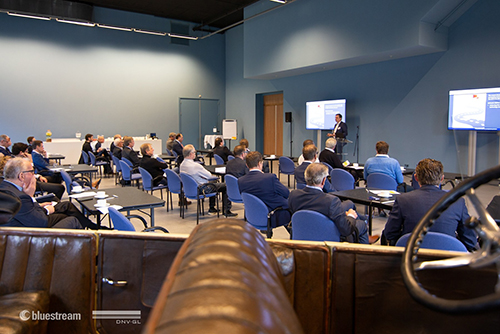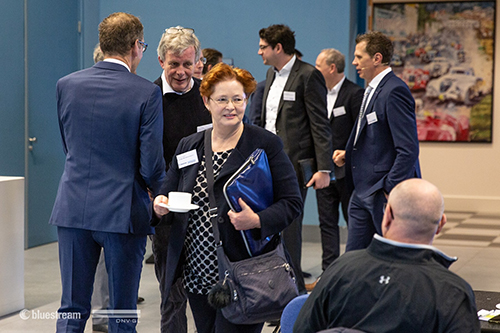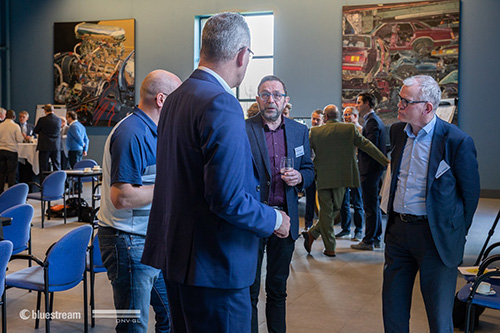Earlier this year, the Annual Dutch Upstream Knowledge Exchange Seminar took place in the Louwman Museum in The Hague for the fourth time in succession. The initiator of the event is DNV GL’s Dutch arm of their oil and gas operations based in Groningen. This year DNV GL once again signed on for organizing the event in collaboration with offshore and subsea contractor Bluestream from Den Helder. The main theme of this informative day for operators was Energy Transition and its impact. This year’s event aimed to transfer and share knowledge and to create awareness about safer, smarter E&P for today, while addressing challenges and opportunities in preparing for the energy mix changes of tomorrow. In total, 14 of the 15 operators who have a ‘Dutch’ concession for the exploration or production of oil and natural gas on shore and offshore participated in this year’s event, as well as representatives of EBN.

The organisers of the Annual Dutch Upstream Knowledge Exchange Seminar.
Energy transition. The word is popping up everywhere nowadays. In the media, in politics. But what is it anyway? In short: the energy transition is the switch from fossil fuels to sustainable energy. The Netherlands wants to emit between 49 and 55% less CO2 by 2030 (compared to 1990). However, the reality is that most of the energy we use still comes from fossil fuels. We heat our houses with oil, natural gas and coal, we drive our cars, and we heat our power plants. The disadvantage of these fossil energy sources is that it is getting warmer all over the world, sea levels are rising and we are increasingly confronted with extreme weather. The intended energy transition must ensure that climate change is curbed as much as possible. However, the key question for operators and contractors remains: can the Netherlands be completely independent of fossil fuels in 2050? Can we switch to a completely green energy system in just 30 years? No more oil, no gas, no coal? Many politicians and proponents claim that it can be achieved by investing heavily in biomass and making hydrogen sustainable; many energy experts state that it is a too ambitious goal. For them it is certain that fossil fuels will certainly continue to play a major role for decades to come. If only because there is not enough sustainable energy yet.
New lease on life
Shortly after the event, Ocean Energy Resources (OER) spoke with Rob Beks, Business Development Manager at DNV GL, and Anton Janssens, Business Development Manager at Bluestream. “As in 2018, our common goal was to provide participants with a ‘growth mindset’ by sharing our vision on the energy transition phenomenon with them,” explains Beks. “Bluestream from the perspective of an inspection company and we as DNV GL in the role of a global quality assurance and risk management company driven by the purpose of safeguarding life, property and the environment. Bluestream thinks practically and looks at the future use of gas producing assets and how subsea ROVs can be used in a more effective way to contribute to asset integrity, while our focus is geared towards a ‘broader view’, helping the industry with advice and assurance to navigate through the energy transition in a safe and smart way across the whole value chain. We do this through globally recognised risk-based approaches and domain expertise in combination with leading digital technologies, many of which are developed together with our customers through Joint Industry Projects (JIPs) and other collaborative initiatives. But operators or contractors can also turn to DNV GL for specific advice in a variety of areas. For example: abandoned oil and gas platforms in the North Sea can be profitably converted into production and storage units that convert electricity from offshore wind farms into hydrogen and synthetic gas. We want operators to permanently think about the realistic consequences of the energy transition and how oil and gas platforms in the North Sea could get a new lease on life. As well as about the role of digitising subsea activities and their verification.”

Attentive listeners during presentation.
Dissension
Janssens adds: “I am happy to note that compared to last year, there has been a positive change in the mindset of many of the operators. Non-operating partner EBN in particular plays a pioneering role in this and develops various ‘sustainable’ initiatives. On the other hand some operators are still investing in the exploration of new gas finds in the North Sea or in the increase of gas production. This dissension within the Dutch upstream world means that energy transition is not yet top of mind for everyone. And, honestly speaking, that is quite understandable for a number of reasons. One of them being that their business model is to extract the last gas from the bottom of the Dutch part of the North Sea.”
Window of opportunity
According to DNV GL’s 2018 Energy Transition Outlook (ETO), a leading impartial voice on the energy future, global spending on energy is set to slow sharply because the world’s energy demand will decline from 2035 onwards. During a presentation in September last year, Remi Eriksen, Group President and CEO of DNV GL, stated: “The attention of boardrooms and cabinets should be fixed on the dramatic energy transition that is unfolding. As money and policy increasingly favour gas and renewables, the rapidly electrifying energy system will deliver efficiency gains that outpace GDP and population growth. This will result in a world needing less energy within half a generation from now. The transition is undeniable. In 2017 more gigawatts of renewable energy were added than those from fossil fuels. Fossil fuels will play an important if reduced role in our energy future with its share of the energy mix set to drop from around 80% today to 50% by the middle of the century, with the other half provided by renewables. Natural gas will become the single largest source in 2026 and it will meet 25% of the world’s energy needs by 2050. Oil will peak in 2023 and coal has already peaked. Solar PV (16% of world energy supply) and wind (12%) will grow to become the most significant players amongst the renewable sources with both set to meet the majority of new electricity demand. We need to capitalise on the affordability of the energy transition and take extraordinary measures to create a sustainable future. We have a window of opportunity to increase energy efficiency, renewable energy and carbon capture and storage to meet the Paris Agreement but we must act now.”
Choice
“If we look at the situation in our own country,” Rob Beks says, “we see that after 2030 no more gas will be extracted from the Groningen gas field. And that in 2050 we will run out of natural gas that is extracted at the NCP. However we will still need natural gas to heat homes that do not have a more sustainable alternative at that time. In the transition to a sustainable energy system, natural gas will continue to play an important role. From an economic and geo-political point of view it would be most desirable to use Dutch gas reserves for this purpose. As Groningen is no longer an option, gas has to come from the Dutch section in the North Sea or we must choose to become dependent on Russian gas.”

Coffee break.
Digitalisation
The energy world is going through a profound transformation as two trends reshape the energy system: decarbonisation and digitalisation. Which role can digitalisation play to meet sustainable energy needs? Digital technologies are important for sustainability, as they can be a key enabler of decarbonisation by helping to integrate higher shares of renewables in the energy system. The electricity sector and smart grids are possible targets of this digital transformation, but ultimately all sectors across both energy supply and demand will be affected. Digitalisation could also play an important role in fostering energy access in developing countries, allowing a leapfrog of traditional energy systems. Rob van der Spek, Head of Asset & Risk Management Services at DNV GL presented his view on this phenomenon as one of the speakers during the event: “Digitalisation leads the R&D shopping list for the coming years. It is one of the most important developments in the context of energy transition. Last year I spoke about remote witnessing and other issues related to digitalisation. This year I would like to emphasize the importance of data sharing and how we can make old data accessible again. We have the tools in our hands, what we need now is the willingness of the operators to make the data available. For upstream companies there are three key priorities: data sharing, integration and access emerge. In order to unlock and leverage the true value of data, DNV GL developed the Veracity platform. By using this open platform offshore operators are able to analyse, control and share their data. We have the tools in our hands, what we need now is the willingness of the operators to make the digital data available. It makes life a lot more pleasant for everyone.” During his presentation, Van der Spek proudly showed the audience the so-called PSV Manager tool, representing a digital analysis of 4,000 PSVs with 10 years of service. Clients have easy access to 12.000 different documents. Thanks to this overwhelming number of data streams vessel owners are able to review failures and address integrity problems. They can also monitor changes in inspection costs, risk and inspection intervals.
Autonomous
The challenge of bringing digitalisation subsea also means that Bluestream is working hard to develop smart ways to not only achieve savings in money and time, but also to ensure improvements in effectiveness in the field of automation and communication. All to optimise the human involvement. “And we are fully engaged in this,” Anton Janssens confirms. “Our focus is mainly on optimising our diverless tools for inspections that need physical contact, such as weld inspections, wall thickness measurements, as well as the way in which we present our inspection results to customers. To become more lean and mean as an organisation we need to convert data into direct usable information faster and smarter.”
“This process already starts on board our diving and ROV support vessels while processing the interim results, but also at our office in Den Helder. Because this is an easier environment to prepare things than when you are in a harsh condition. In order to contribute to a more smooth inspection campaign, we are splitting our activities into a package that can be handled at sea and a package that can be done at the office. As our Technical Director Adrian Winckers explained in his presentation autonomous inspection of subsea structures is not yet around the corner. We are making good progress but a lot of work still has to be done in the field of subsea communication and visual recognition. What we can unveil is that recent developments in data acquisition, data processing and communication are enormous and our offshore oil, gas and renewable clients will soon be able to benefit from our ongoing efforts.”
Life-changer
All those present at the fourth Annual Dutch Upstream Knowledge Exchange Seminar clearly agreed on one thing: the energy transition is much more than just a switch from conventional energy generation to producing electricity from renewables. Digitalisation is a life-changer for all of us – at a societal, economic and political level. Without it, the energy transition would be impossible. Only the use of the latest digital technologies and the intelligent use of data make it possible for us to venture along new paths in a world of decentralised energy.

Discussion about digitalisation.
